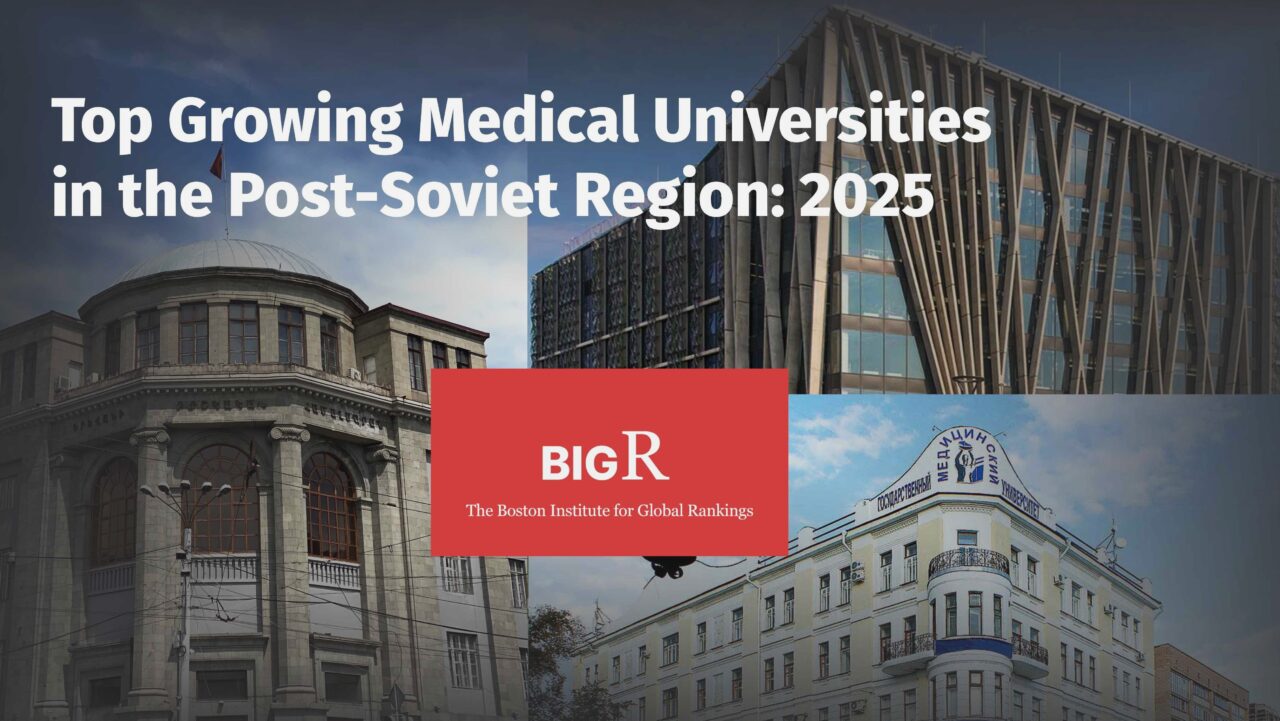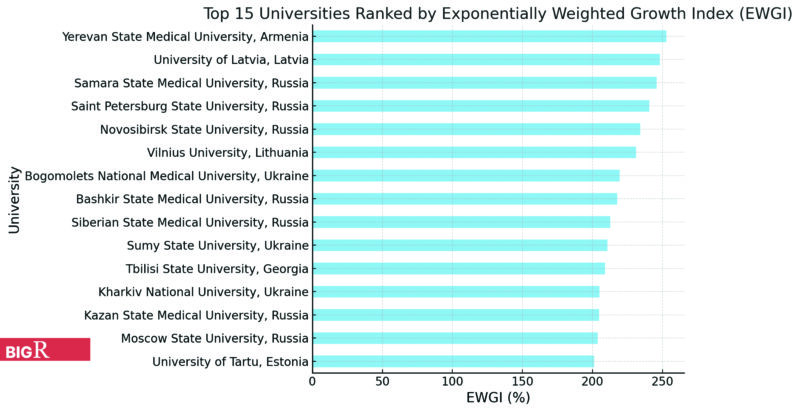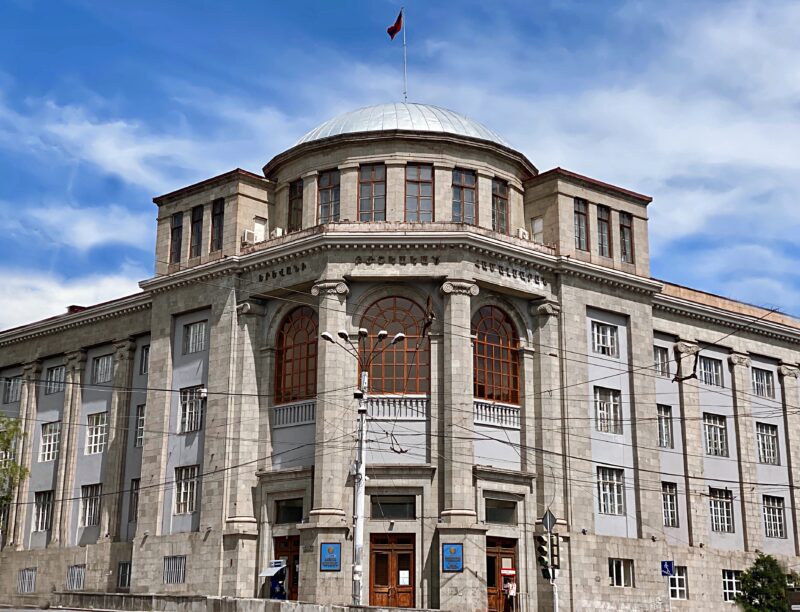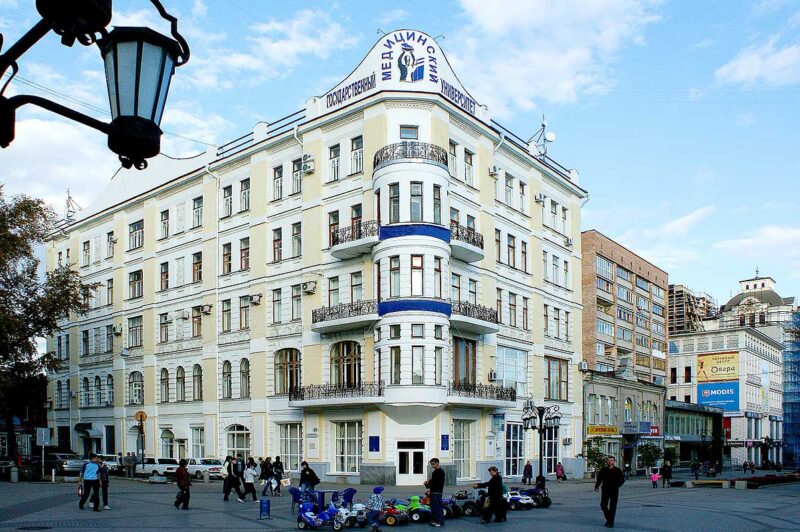
Top Growing Medical Universities in the Post-Soviet Region – BIGR 2025 Edition
Introduction: Top Growing Medical Universities and the Scientific Renaissance of the Post-Soviet Space
Since the collapse of the Soviet Union in 1991, medical universities across Eastern Europe, the Baltics, the Caucasus, and Central Asia have experienced profound transformations. Initially facing severe resource constraints and systemic challenges, these institutions embarked on journeys to integrate themselves into the competitive global scientific community. Over more than three decades, many of these universities have significantly increased their scientific research output, achieving international visibility and recognition.
To capture and measure this evolution, we conducted an in-depth analysis of scientific publications indexed by the National Library of Medicine (PubMed) from 1991 to 2024, as part of the inaugural 2025 edition of the ranking. Our goal was simple yet ambitious: identify and rank the medical universities in the post-Soviet region that demonstrated the most remarkable growth in scientific output, emphasizing recent developments while accounting for their historical context.
Scope of the Study: From Hundreds to a Select Few
Our analysis began with the World Directory of Medical Schools, comprising 249 medical institutions across the post-Soviet region (Armenia, Azerbaijan, Belarus, Estonia, Georgia, Kazakhstan, Kyrgyzstan, Latvia, Lithuania, Moldova, Russia, Tajikistan, Turkmenistan, Ukraine, and Uzbekistan). However, to ensure that our ranking was both meaningful and credible, we established a key inclusion criterion: only universities with at least 500 publications indexed in PubMed during the 1991-2024 period were considered. This filter narrowed our focus to a select group of universities that had demonstrated substantial and sustained scientific activity.
Why Measure Growth in Research Output?
Scientific publications are a fundamental measure of a university’s contribution to global knowledge and innovation. They reflect not only the quantity of research but also its relevance and impact. For emerging universities, particularly those navigating post-Soviet transitions, increased publication activity is a strong indicator of modernization, investment in faculty development, and successful integration into the international academic community.
The Method Behind the Momentum: How We Identified the Top Growing Medical Universities
To fairly evaluate growth, we needed a method that would:
- Reward recent achievements without ignoring historical contributions.
- Avoid arbitrary cutoffs like “last 5 years” or “last 10 years.”
We developed and utilized the Exponentially Weighted Growth Index (EWGI). Here’s how it works:
Step 1: Assigning Exponential Weights Each year from 1991 to 2024 was assigned a weight that naturally emphasized more recent years. Using a decay parameter (τ) of 7 years, the formula for each year’s weight was: This ensured that, for example, an article published in 2022 had more influence than one from 2002, but every publication contributed.
Step 2: Calculating Weighted Average Growth (WAG) We multiplied each year’s publication count by its respective weight and divided the sum of these products by the total sum of weights.
Step 3: Calculating Historical Average (HA) We computed the simple, unweighted average number of publications from 1991 to 2024. In calculating the historical average (HA), only the years during which the university had nonzero publications were considered. Years without any publications were excluded from the denominator to ensure a fair reflection of active scientific productivity, avoiding distortion caused by inactive periods.
Step 4: Computing the EWGI Finally, we calculated the EWGI by dividing the WAG by the HA and multiplying by 100. An EWGI greater than 100% indicates a university’s scientific productivity has accelerated relative to its historical norm.
This method allowed us to naturally highlight institutions experiencing real, sustained growth—not just a temporary spike.
The 2025 List: Meet the Top Growing Medical Universities in the Post-Soviet World
The results revealed fascinating insights into the evolving scientific landscape. Here are the universities that lead the pack:
- Yerevan State Medical University, Armenia – 252.9%
- University of Latvia, Latvia – 248.0%
- Samara State Medical University, Russia – 245.9%
- Saint Petersburg State University, Russia – 240.7%
- Novosibirsk State University, Russia – 234.1%
- Vilnius University, Lithuania – 231.1%
- Bogomolets National Medical University, Ukraine – 219.5%
- Bashkir State Medical University, Russia – 217.7%
- Siberian State Medical University, Russia – 212.8%
- Sumy State University, Ukraine – 210.8%
- Tbilisi State University, Georgia – 209.0%
- Kharkiv National University, Ukraine – 204.9%
- Kazan State Medical University, Russia – 204.8%
- Moscow State University, Russia – 203.6%
- University of Tartu, Estonia – 201.3%
- Al-Farabi Kazakh National University, Kazakhstan – 194.2%
- Rīga Stradiņš University, Latvia – 193.3%
- Tbilisi State Medical University, Georgia – 184.9%
- Lobachevsky State University, Russia – 184.4%
- Lviv National Medical University, Ukraine – 179.4%
- Pavlov State Medical University, Russia – 166.0%
- National University of Kyiv, Ukraine – 165.7%
- Kazakh National Medical University, Kazakhstan – 165.5%
- Volgograd State Medical University, Russia – 164.5%
- Moscow State Medical University, Russia – 153.8%
- Krasnoyarsk State Medical University, Russia – 144.0%
- Russian National Research Medical University, Russia – 142.0%
- Kharkiv National Medical University, Ukraine – 141.6%
- Ilia State University, Georgia – 138.8%
- Nazarbayev University, Kazakhstan – 137.8%
- Baltic Federal University, Russia – 135.6%
- Lithuanian University of Health Sciences, Lithuania – 135.3%
- Novosibirsk State Medical University, Russia – 134.1%
- Kazan Federal University, Russia – 132.6%
- National Research Nuclear University MEPhI, Russia – 128.1%
- North-Western State Medical University, Russia – 121.1%
- Far Eastern Federal University, Russia – 118.9%
- Ural State Medical University, Russia – 112.6%
- Privolzhsky Research Medical University, Russia – 111.2%
- Almazov National Medical Research Centre, Russia – 109.0%
- Ternopil National Medical University, Ukraine – 106.0%

Yerevan State Medical University – Armenia’s Scientific Powerhouse
Founded in 1920 and named after the 12th-century physician Mkhitar Heratsi, Yerevan State Medical University (YSMU) has grown into Armenia’s premier center for medical education and research. With over 8,000 students and a strong international presence, YSMU has become a leader in clinical training, biomedical research, and public health innovation. Through its modern hospital complexes, international collaborations, and a strong research-oriented faculty, YSMU has positioned itself as one of the fastest-growing medical universities not only in the region but globally.

Photo from the Yerevan State Medical University’s website
University of Latvia – A Historic Leader Reimagining Medical Science
Since its founding in 1919, the University of Latvia has played a pivotal role in shaping the intellectual and scientific landscape of the Baltic region. With a strong foundation built upon European academic traditions, it has consistently expanded its influence in medical research, healthcare innovation, and interdisciplinary collaboration. Today, with over 15,000 students and active participation in major international networks, the University of Latvia exemplifies how historical institutions can reinvent themselves for global leadership in scientific advancement.

Photo from the University of Latvia’s website
Samara State Medical University – Pioneering the Future of Russian Medicine
With a proud history stretching over a century, Samara State Medical University (SamSMU) has established itself as one of Russia’s top medical universities. Hosting more than 6,000 students, including a vibrant community of international scholars, SamSMU is at the forefront of medical education and technological innovation. With 8 specialized institutes, 15 diagnostic and therapeutic centers, and a dynamic research ecosystem, Samara is not only shaping the future of healthcare in Russia but also making a mark on the global medical community.

Photo from the Samara State Medical University’s website
Lessons for the World: What Every University Can Learn from the Top Growing Medical Universities
Several strategic pillars underpin the remarkable ascent of the leading universities. First and foremost is investment in research infrastructure. The top-performing institutions have consistently prioritized building state-of-the-art laboratories and clinics, expanding access to cutting-edge technologies. These investments have created environments where research can flourish, students can be properly trained, and faculty members can produce internationally competitive work.
Another cornerstone of success is international collaboration. The top universities did not grow in isolation; they actively pursued partnerships with leading institutions in Europe, North America, and beyond. These collaborations facilitated joint research projects, participation in multi-center studies, access to international funding, and crucially, the exchange of knowledge and best practices. Many leading universities have also engaged in formalized dual-degree and research exchange programs, further integrating themselves into the global academic community.
Faculty development has been equally instrumental. Recognizing that institutions are only as strong as their educators and researchers, top universities have invested heavily in their people. Programs were developed to send young researchers abroad for training, encouraging them to bring back international standards of research ethics, methodology, and publication practices. Moreover, many institutions incentivized faculty to obtain Ph.D. degrees aligned with international standards, thereby elevating the overall research culture and academic rigor.
Finally, publication incentives played a significant role. Universities leading this growth wave implemented transparent reward systems for publishing in indexed and high-impact journals. Researchers were encouraged—and in many cases financially rewarded—for producing work that achieved international visibility. Such initiatives not only motivated individual researchers but also helped institutions climb international rankings, attract external funding, and build their reputations globally.
Together, these four pillars—infrastructure investment, international collaboration, faculty development, and publication incentives—formed the foundation upon which the remarkable scientific growth of these universities was built. Their experiences provide invaluable blueprints for other institutions aspiring to elevate their status and impact on the global stage.
Looking to the Future
The continued growth and integration of these medical universities into the global research community will depend heavily on sustained strategic investment, innovative research environments, and strengthened international cooperation. With their growth momentum clearly established, the top universities from this analysis are well-positioned to become leaders in global scientific innovation.
Final Thoughts
This ranking not only celebrates success but also provides a roadmap for other universities in emerging regions. By understanding the strategies that worked and the investments that paid off, institutions can craft their pathways toward greater global influence and scientific leadership.
The Exponentially Weighted Growth Index (EWGI) provides a rigorous, fair, and forward-looking way to measure scientific momentum—an essential metric in our rapidly evolving world.
This analysis was performed by The Boston Institute for Global Rankings (BIGR). BIGR is an academic initiative committed to advancing transparent, data-driven evaluation of excellence across universities, medical centers, and healthcare professionals worldwide. With a focus on performance, impact, and innovation, BIGR aspires to shape meaningful benchmarks for the future. Think BIGR.
You can follow our other rankings and analyses on the OncoDaily website, where we continue to highlight excellence and innovation in global healthcare and education.
-
Challenging the Status Quo in Colorectal Cancer 2024
December 6-8, 2024
-
ESMO 2024 Congress
September 13-17, 2024
-
ASCO Annual Meeting
May 30 - June 4, 2024
-
Yvonne Award 2024
May 31, 2024
-
OncoThon 2024, Online
Feb. 15, 2024
-
Global Summit on War & Cancer 2023, Online
Dec. 14-16, 2023
